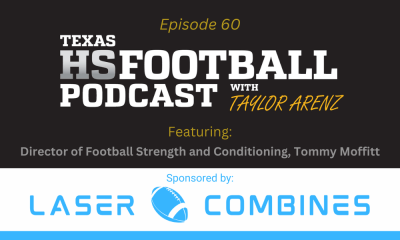
The University Interscholastic League (UIL), the governing body of Texas high school athletics, announced Wednesday it will move forward with a split of 5A football into two separate divisions beginning with the 2018-19 realignment.
The 5A football teams at schools with large enrollments will go into Division I while the smaller schools will go Division II. The vote passed, 144-77, by the superintendents.
The current setup has one 5A Conference with 32 districts, with four teams from each district making the playoffs. The two teams from each district with the highest enrollment go into Division I — regardless of how they finished in district — while the other two with smaller enrollment go Division II.
In the new alignment, 5A will have two divisions with 16 districts in each one. Four teams from each district will still make the playoffs. Current 5A enrollment is between 1,100 and 2,149. Should those numbers be split in half, the cutoff number for Division I would be 1,742.
A big part of the reason the UIL has split divisions is to bring districts together that are more closely related in enrollment sizes. Schools Class 4A-1A already use predetermined split divisions.
There are both positives and negatives that come from a split. Here are some of those:
Pro — Similar size schools in district play
It levels the playing field in district play, pairing schools more equivalent in size. This move will take Elgin (1,305) out of the same district with Cedar Park (1,949), Georgetown (1,876) and Leander Rouse (2,006) and put the Wildcats into a district with Bastrop (1,348), Cedar Creek (1,438) and other schools of comparable size.
Con — Taking away from rivalries
A team like Elgin would get removed from a district that it’s built rivals with over the years. However, they can still schedule each other in non-district play, but that’s up to each school’s respective coaches.
Pro — Scouting for playoffs
Currently, a team might have to scramble the weekend prior to the playoffs to know its next opponent. Let’s say in District 15-5A that Mesquite Poteet (1,816) has clinched a playoff spot behind Highland Park (2,116), but if Wylie East (1,832) and/or West Mesquite (1.978) win in the last week, then Poteet would go Division II. But if West Mesquite and Wylie East both lose, then Poteet goes DI. Meanwhile, they’re first-round opponent is going through the same scenario in District 16 in Week 11. Definitive divisions eliminate a lot of late-season confusion.
Con — Travel
Face it, some teams are going to travel a long ways in current districts. It happens in West Texas and in the Rio Grande Valley. But those long travels come into play in Central and East Texas, and road trips for South and West Texas could get even longer. That puts a strain on budgets for those Friday nights when the team, the band, cheerleaders and fans make long trips. The underlying effect, one that no one talks about, is the fact that the freshman and JV teams are making those same long trips the night before varsity plays. In the nine-team District 22-5A, only Port Arthur Memorial (2.098), Baytown Lee (1,669) and Nederland (1,596) fall above that 1,472 mark. Travel to district games gets significantly longer for those teams.
Pro — New rivalries can emerge
Though it’s tough to leave long-time district rivalries behind, playing a new district foe for a district championship can start a new rivalry that can carry over into other sports and their respective playoff seasons.
Con — The volleyball effect
Ok, volleyball isn’t football, but volleyball is still a big part of Texas high school sports. In cases when the football and volleyball districts are the same, the district schedule is most often set up so the teams are playing at the same site on the same day, therefore allowing fans to support both teams. In split divisions, as we’ve seen in 4A-1A, the volleyball team could be playing 100-200 miles away from the football team on Friday night. This makes it extraordinarily difficult for parents who have a kid on each team, or the cheerleaders who also play varsity volleyball.
But, football is still king in Texas. Good teams and programs will win whether they’re in a district with larger enrollments or not. Navasota was the smallest 4A Division I team in the state when it won the state championship in 2014. Aledo (1,594) is by far the smallest school in District 6-5A, but they went undefeated last year and won the 5A Division II state championship over Corpus Christi Calallen, which is the second-smallest school in District 30-5A at 1,260.
Brought to you by:


















